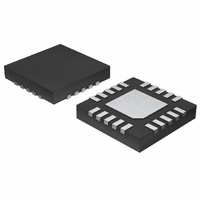MAX17006BETP+ Maxim Integrated Products, MAX17006BETP+ Datasheet - Page 18

MAX17006BETP+
Manufacturer Part Number
MAX17006BETP+
Description
IC BATT CHARGER 1.2MHZ 20-TQFN
Manufacturer
Maxim Integrated Products
Specifications of MAX17006BETP+
Function
Charge Management
Battery Type
Multi-Chemistry
Voltage - Supply
8 V ~ 26 V
Operating Temperature
-40°C ~ 85°C
Mounting Type
Surface Mount
Package / Case
20-TQFN Exposed Pad
Lead Free Status / RoHS Status
Lead free / RoHS Compliant
The following additional loss occurs in the low-side
MOSFET due to the body diode conduction losses:
The total power low-side MOSFET dissipation is:
These calculations provide an estimate and are not a
substitute for breadboard evaluation, preferably including
a verification using a thermocouple mounted on the
MOSFET.
The selection of the inductor has multiple trade-offs
between efficiency, transient response, size, and cost.
Small inductance is cheap and small, and has a better
transient response due to higher slew rate; however, the
efficiency is lower because of higher RMS current. High
inductance results in lower ripple so that the need of the
output capacitors for output-voltage ripple goes low.
The MAX17005B/MAX17006B/MAX17015B combine all
the inductor trade-offs in an optimum way by controlling
switching frequency. High-frequency operation permits
the use of a smaller and cheaper inductor, and conse-
quently results in smaller output ripple and better tran-
sient response.
The charge current, ripple, and operating frequency
(off-time) determine the inductor characteristics. For
optimum efficiency, choose the inductance according
to the following equation:
where k = 35ns/V.
For optimum size and inductor current ripple, choose
LIR
charge current and results in a good balance between
inductor size and efficiency. Higher inductor values
decrease the ripple current. Smaller inductor values
save cost but require higher saturation current capabili-
ties and degrade efficiency.
Inductor L1 must have a saturation current rating of at
least the maximum charge current plus 1/2 the ripple
current (∆I
1.2MHz, Low-Cost,
High-Performance Chargers
18
MAX
______________________________________________________________________________________
PD
= 0.4, which sets the ripple current to 40% the
L
TOTAL
):
PD
BDY
I
( )
L
SAT
LS
=
( )
LS
4
≈
= I
×
PD
=
CHG
I
CHG
0 05
COND
k V
.
×
+ (1/2) ∆I
×
×
IN
LIR
I
( )
Inductor Selection
PEAK
LS
2
MAX
+
PD
×
L
0 4
BDY
.
V
( )
LS
The ripple current is determined by:
The input capacitor must meet the ripple current
requirement (I
Nontantalum chemistries (ceramic, aluminum, or
OS-CON) are preferred due to their resilience to power-
up and surge currents:
The input capacitors should be sized so that the tem-
perature rise due to ripple current in continuous conduc-
tion does not exceed approximately 10°C. The
maximum ripple current occurs at 50% duty factor or
V
application of interest does not achieve the maximum
value, size the input capacitors according to the worst-
case conditions.
The output capacitor absorbs the inductor ripple cur-
rent and must tolerate the surge current delivered from
the battery when it is initially plugged into the charger.
As such, both capacitance and ESR are important
parameters in specifying the output capacitor as a filter
and to ensure the stability of the DC-to-DC converter
(see the Compensation section.) Beyond the stability
requirements, it is often sufficient to make sure that the
output capacitor’s ESR is much lower than the battery’s
ESR. Either tantalum or ceramic capacitors can be
used on the output. Ceramic devices are preferable
because of their good voltage ratings and resilience to
surge currents. Choose the output capacitor based on:
Choose k
rated ceramic capacitors.
For f
70mV, choose C
If the internal resistance of battery is close to the ESR of
the output capacitor, the voltage ripple is shared with
the battery and is less than calculated.
DCIN
SW
= 2 x V
I
RMS
= 800kHz, I
C
CAP-BIAS
OUT
=
I
RMS
BATT
CHG
=
OUT
f
SW
) imposed by the switching currents.
is a derating factor of 2 for typical 25V-
×
, which equates to 0.5 x I
Output Capacitor Selection
RIPPLE
⎛
⎜
⎜
⎝
∆ =
× ×
as 4.7µF.
I
RIPPLE
I
Input Capacitor Selection
L
8 ∆
V
CSIN
k V
V
= 1A, and to get ∆V
×
CSIN
4
×
L
IN
(
V
V
DCIN
2
DCIN
×
k
CAP BIAS
-
V
CSIN
−
CHG
)
⎞
⎟
⎟
⎠
BATT
. If the
=











